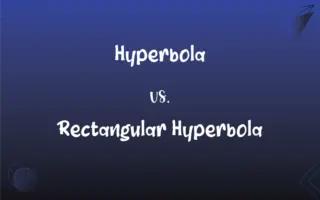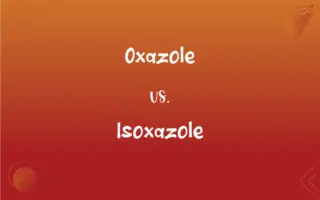Cholecystitis vs. Cholelithiasis: What's the Difference?
By Aimie Carlson & Harlon Moss || Published on May 4, 2024
Cholecystitis is the inflammation of the gallbladder, often caused by gallstones blocking the duct, while Cholelithiasis refers to the presence of gallstones in the gallbladder without necessarily causing inflammation.

Key Differences
Cholecystitis usually results from a blockage in the gallbladder's duct, most commonly by gallstones, leading to inflammation and potentially severe abdominal pain. Cholelithiasis, on the other hand, involves the formation of gallstones within the gallbladder, which may or may not cause symptoms depending on their size and movement.
Cholecystitis often presents with acute symptoms, such as sharp pain in the upper right abdomen, fever, and nausea, cholelithiasis might remain asymptomatic for long periods. Patients with cholelithiasis may experience symptoms if a stone obstructs the bile duct, leading to pain similar to cholecystitis.
The diagnosis of cholecystitis often involves ultrasound imaging to detect inflammation and gallstones, whereas cholelithiasis is diagnosed primarily through the identification of gallstones in the gallbladder. Both conditions may require an ultrasound, but the focus differs based on symptoms and clinical presentation.
Treatment for cholecystitis may include antibiotics, pain management, and often surgery to remove the gallbladder to prevent further complications. In contrast, cholelithiasis treatment focuses on managing symptoms and may involve medication to dissolve gallstones or surgery if they cause significant issues.
Preventive measures for both conditions include maintaining a healthy weight, eating a balanced diet, and managing cholesterol levels. However, individuals with cholelithiasis need to be aware of the potential for gallstones to cause blockages, leading to cholecystitis.
ADVERTISEMENT
Comparison Chart
Definition
Inflammation of the gallbladder
Presence of gallstones in the gallbladder
Causes
Usually gallstones blocking the duct
Formation of stones due to bile imbalances
Symptoms
Sharp pain, fever, nausea
Often asymptomatic, pain if duct is blocked
Diagnosis
Ultrasound to detect inflammation and gallstones
Ultrasound to identify gallstones
Treatment
Antibiotics, pain management, gallbladder removal
Symptom management, possibly gallbladder removal
ADVERTISEMENT
Cholecystitis and Cholelithiasis Definitions
Cholecystitis
An acute or chronic inflammation of the gallbladder.
Acute cholecystitis can cause severe upper abdominal pain that may radiate to the back.
Cholelithiasis
The condition of having gallstones.
An ultrasound confirmed the diagnosis of cholelithiasis.
Cholecystitis
Requires medical intervention, possibly surgery.
Due to recurrent cholecystitis, the patient underwent a cholecystectomy.
Cholelithiasis
Gallstones may be cholesterol or pigment stones.
The patient's cholelithiasis was caused by cholesterol stones.
Cholecystitis
Often triggered by gallstone blockage.
The patient's cholecystitis was a result of a gallstone obstructing the cystic duct.
Cholelithiasis
Risk factors include obesity and diet.
The patient's obesity increased their risk for developing cholelithiasis.
Cholecystitis
Symptoms include pain, fever, and vomiting.
Symptoms of cholecystitis led to an emergency room visit.
Cholelithiasis
Can exist without causing symptoms.
Despite having cholelithiasis, the patient experienced no abdominal pain.
Cholecystitis
Can lead to complications like infection.
Without treatment, cholecystitis can progress to a gallbladder infection.
Cholelithiasis
Treatment depends on symptom presence.
Asymptomatic cholelithiasis in the patient did not require immediate surgery.
Cholecystitis
Inflammation of the gallbladder.
Cholelithiasis
The presence or formation of gallstones in the gallbladder or bile ducts.
Cholecystitis
(disease) An inflammation of the gall bladder.
Cholelithiasis
(medicine) gallstones
Cholecystitis
Inflammation of the gall bladder
Cholelithiasis
The presence of gallstones in the gallbladder
FAQs
Can Cholelithiasis lead to Cholecystitis?
Yes, gallstones from cholelithiasis can block the gallbladder duct, leading to cholecystitis.
What is Cholecystitis?
It's the inflammation of the gallbladder, often due to gallstones blocking its duct.
How do symptoms of Cholecystitis and Cholelithiasis differ?
Cholecystitis typically causes severe pain and fever, while cholelithiasis may be asymptomatic or cause mild discomfort.
What are the treatments for Cholecystitis?
Treatments include antibiotics, pain relief, and often surgical removal of the gallbladder.
What causes Cholelithiasis?
It's caused by imbalances in the bile that lead to the formation of gallstones in the gallbladder.
What preventive measures can reduce the risk of Cholelithiasis?
Maintaining a healthy weight, eating a balanced diet, and managing cholesterol levels can help.
Is surgery always required for Cholelithiasis?
No, surgery is considered if gallstones cause significant symptoms or complications.
Are there any lifestyle changes recommended for patients with Cholelithiasis?
Yes, adopting a healthy diet, regular exercise, and avoiding rapid weight loss are recommended.
What are the risk factors for developing Cholecystitis?
Risk factors include gallstones, obesity, a high-fat diet, and rapid weight loss.
How is Cholecystitis diagnosed?
Through clinical evaluation and imaging tests like ultrasound, which show gallstones and signs of inflammation.
Can Cholecystitis be chronic?
Yes, repeated episodes of acute cholecystitis can lead to chronic cholecystitis, characterized by gallbladder scarring and dysfunction.
How quickly do symptoms of Cholecystitis develop?
Symptoms can develop rapidly, often within hours of a gallstone blocking the duct, leading to severe pain and discomfort.
Can Cholelithiasis affect people of any age?
While it can affect people of any age, cholelithiasis is more common in adults, particularly those over 40.
Why is Cholecystitis considered an emergency?
Because it can lead to complications like gallbladder rupture, infection, and sepsis, requiring prompt medical treatment.
Can losing weight reduce the risk of Cholelithiasis?
Yes, but weight loss should be gradual, as rapid weight loss can actually increase the risk of gallstones.
Can Cholelithiasis recur after treatment?
If the gallbladder is removed, gallstones cannot recur, but stones can form in the bile ducts in rare cases.
What are non-surgical treatments for Cholelithiasis?
Non-surgical options include oral bile acid pills to dissolve cholesterol gallstones and shock wave lithotripsy to break up stones, though these methods are less common and not suitable for everyone.
How long does recovery from Cholecystectomy (gallbladder removal) take?
Recovery can vary, but many patients return to normal activities within a week, although full recovery may take up to six weeks.
What dietary changes can help manage Cholelithiasis?
Eating high-fiber foods, reducing intake of refined sugars and fats, and maintaining a balanced diet can help manage and prevent gallstones.
Is there a genetic predisposition to Cholelithiasis?
Yes, genetics can play a role, with a higher prevalence in certain families and ethnic groups.
About Author
Written by
Aimie CarlsonAimie Carlson, holding a master's degree in English literature, is a fervent English language enthusiast. She lends her writing talents to Difference Wiki, a prominent website that specializes in comparisons, offering readers insightful analyses that both captivate and inform.
Co-written by
Harlon MossHarlon is a seasoned quality moderator and accomplished content writer for Difference Wiki. An alumnus of the prestigious University of California, he earned his degree in Computer Science. Leveraging his academic background, Harlon brings a meticulous and informed perspective to his work, ensuring content accuracy and excellence.






































































